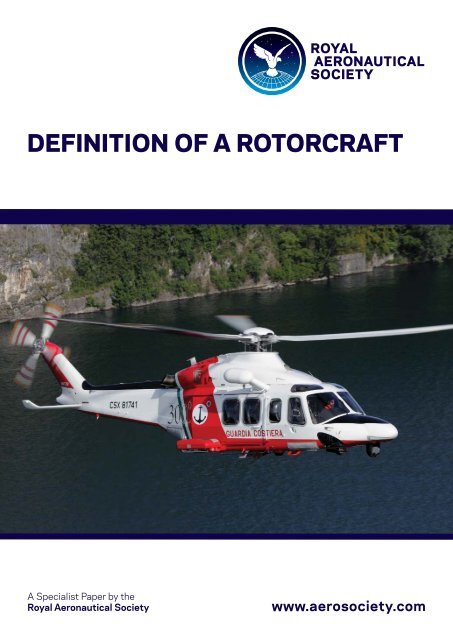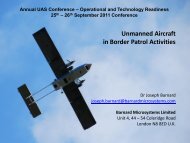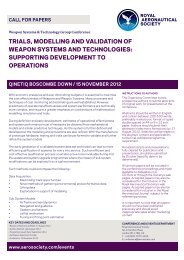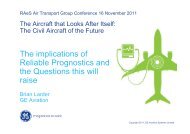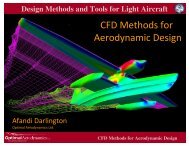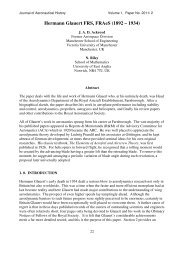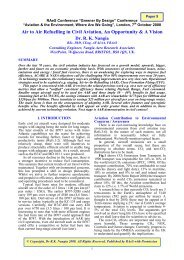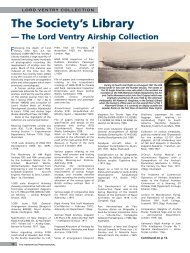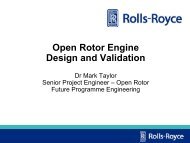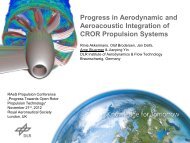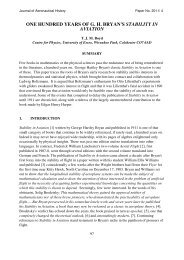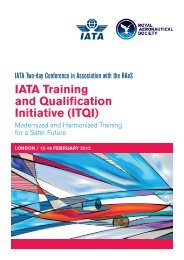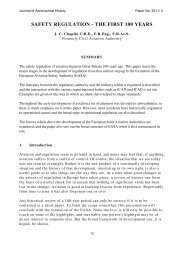DEFINITION OF A ROTORCRAFT - Royal Aeronautical Society
DEFINITION OF A ROTORCRAFT - Royal Aeronautical Society
DEFINITION OF A ROTORCRAFT - Royal Aeronautical Society
Create successful ePaper yourself
Turn your PDF publications into a flip-book with our unique Google optimized e-Paper software.
<strong>DEFINITION</strong> <strong>OF</strong> A <strong>ROTORCRAFT</strong><br />
A Specialist Paper by the<br />
<strong>Royal</strong> <strong>Aeronautical</strong> <strong>Society</strong> www.aerosociety.com
2<br />
<strong>Royal</strong> <strong>Aeronautical</strong> <strong>Society</strong> - Definition of a Rotorcraft<br />
<strong>DEFINITION</strong> <strong>OF</strong> A <strong>ROTORCRAFT</strong><br />
Jeremy Graham, MRAeS<br />
Chairman, Rotorcraft Group<br />
Front cover: A typical helicopter configuration, the AgustaWestland AW139.<br />
AgustaWestland photo.<br />
This Paper represents the views of the Rotorcraft<br />
Group of the <strong>Royal</strong> <strong>Aeronautical</strong> <strong>Society</strong>. It has not<br />
been discussed outside the Learned <strong>Society</strong> Board<br />
and, as such, it does not necessarily represent the<br />
views of the <strong>Society</strong> as a whole, or any other<br />
Specialist Group or Committee.<br />
February 2013<br />
ROYAL AERONAUTICAL SOCIETY<br />
No.4 Hamilton Place<br />
London W1J 7BQ<br />
United Kingdom<br />
T +44 (0)20 7670 4300<br />
E raes@aerosociety.com<br />
www.aerosociety.com
Eurocopter X3. Eurocopter photo.<br />
BACKGROUND<br />
The FAI Sporting Code is recognised worldwide as defining<br />
all aspects of internationally recognised aeronautical<br />
achievements and associated records. The code has developed<br />
definitions of aircraft types with some considerable<br />
care and has evolved these definitions as required to suit new<br />
configurations of air vehicle as they have come to the fore.<br />
Recently, resurgence in the unconventional rotorcraft has<br />
occurred in the USA, Europe and possibly Russia. In particular<br />
Sikorsky has test flown the X2 and Eurocopter the<br />
X3, both of which have shown by demonstration an ability<br />
to outpace the traditional edge wise rotorcraft in respect of<br />
speed, agility, operating ceiling and rate of climb. Of these<br />
artefacts, speed, ceiling and rate of climb are all recognised<br />
candidates for FAI Class and Absolute records.<br />
This note suggests that the time is right to request that<br />
the FAI revise the stated definition of aircraft types so as<br />
to correctly identify and reward the ingenuity and skill of<br />
the teams that create aerospace products that advance<br />
the state of the art. All standard definitions used below are<br />
taken directly from the FAI Sporting Code, as available from<br />
the FAI via their web site.<br />
DISCUSSION<br />
The FAI Sporting Code defines a ‘Rotorcraft’ as an “aerodyne<br />
that derives the whole or a substantial part of its lift from<br />
a rotary wing system.” An ‘aerodyne’ is “an aircraft, heavierthan-air,<br />
that can be dynamically sustained in the air by the<br />
reaction of the air upon surfaces in relative movement.”<br />
Definition of a Rotorcraft - <strong>Royal</strong> <strong>Aeronautical</strong> <strong>Society</strong><br />
A ‘helicopter’ is defined by the FAI as “a rotorcraft which,<br />
in flight, derives substantially the whole of its lift from a<br />
power-driven rotor system whose axis (axes) is (are) fixed<br />
and substantially perpendicular to the longitudinal axis of<br />
the rotorcraft.”<br />
It is perhaps worthy of note that the tilt rotor configuration<br />
is specifically defined in its own right within the definition of<br />
Class E Rotorcraft. The convertible nature of this configuration<br />
clearly makes a strict comparison with rotorcraft configurations<br />
that cannot convert from one mode of flight to<br />
another virtually meaningless. This is a good example where<br />
records awarded to one configuration must be judged as recognition<br />
of endeavour that is different in a fundamental way<br />
from records awarded to another. It is for this reason that<br />
the FAI defines different types of aeroplanes and rotorcraft<br />
in the first place.<br />
It is clearly important that the definitions used by the FAI<br />
properly and correctly differentiate between fundamentally<br />
different configurations of rotorcraft. The traditional helicopter<br />
derives both lift and longitudinal thrust from a power<br />
driven rotor that is substantially perpendicular to the axis of<br />
the rotorcraft. The FAI definition makes no mention of longitudinal<br />
thrust, only lift acting substantially perpendicular to<br />
the axis of the rotorcraft. It is a matter of great achievement<br />
that the edgewise rotor unsupported by fixed lifting surfaces<br />
and operating in the most complex aerodynamic conditions<br />
is able to achieve high speed. The speed record for a helicopter<br />
relying substantially on thrust generated by an edgewise<br />
rotor for lift and forward propulsion is an achievement to be<br />
uniquely celebrated and not confused with other rotorcraft<br />
configurations that may be equally worthy of reward but for<br />
different reasons.<br />
3
4<br />
<strong>Royal</strong> <strong>Aeronautical</strong> <strong>Society</strong> - Definition of a Rotorcraft<br />
Sikorsky X2. Sikorsky photo.<br />
The Sikorsky X2 would today be classed as a helicopter<br />
according to the FAI definitions but cannot achieve high<br />
speed without the aid of a propulsor acting in concert with<br />
the advancing blade concept rotor. At high speed main rotor<br />
drag is minimised by keeping the rotor disc sensibly aligned<br />
to the direction of flight, in which orientation it cannot produce<br />
substantive longitudinal thrust; lift is assigned to the<br />
rotor and forward thrust to the propulsor. The ingenuity that<br />
should be rewarded is that the classic advancing/retreating<br />
blade restrictions of the edge wise rotor have been overcome<br />
without reliance on fixed lifting surfaces by application<br />
of the ABC configuration.<br />
Similarly, the use of fixed lifting surfaces operating in conjunction<br />
with a traditional edge wise rotor and auxiliary propulsors<br />
can achieve a variety of performance improvements<br />
when compared to a classic helicopter by separating out lift<br />
from longitudinal thrust. This is a recognised configuration<br />
that has flown in experimental forms over many years but<br />
is currently best appreciated in the guise of the Eurocopter<br />
X3, which has demonstrated substantial performance benefits<br />
over the conventional helicopter. Ironically this configuration<br />
may not even be sensibly covered by an approved FAI<br />
definition and so may be ineligible for reward in respects of<br />
recognised records. If the fixed lifting surface generates a<br />
large proportion of the overall lift available then the X3 may<br />
not be considered as a helicopter or a even a rotorcraft when<br />
operating at speed. It is clearly not a tilt rotor or a tilt wing<br />
and neither can it be defined as a vertical take-off and landing<br />
aeroplane since this must, according to the FAI, derive<br />
its lift at low speed from engine thrust.<br />
It is suggested that the current FAI definitions of aircraft<br />
types is inadequate to describe the emerging class of rotorcraft<br />
that are aiming to enhance performance by the separation<br />
of lift and longitudinal thrust forces.<br />
RECOMMENDATION<br />
The addition of a fixed lifting surface, auxiliary propulsor, or<br />
a combination of both to the classic helicopter configuration<br />
defines a ‘compound helicopter’. This term is well established<br />
and should be used to differentiate these rotorcraft from the<br />
classic edgewise rotor helicopter that generates substantially<br />
all lifting and longitudinal propulsion from the same<br />
power driven rotor(s).<br />
To establish and differentiate helicopters from compound<br />
helicopters the following definition is suggested:<br />
a) The helicopter is defined as “a rotorcraft which, in flight,<br />
derives substantially the whole of its lift and longitudinal<br />
thrust throughout the flight envelope from a power<br />
driven rotor system whose axis (axes) is (are) fixed and<br />
substantially perpendicular to the longitudinal axis of<br />
the rotorcraft.”<br />
b) The compound helicopter is defined as “a rotorcraft<br />
which, in flight, and at slow speed derives the substantial<br />
proportion of its lift from a rotary wing system but at<br />
speed can generate lifting and longitudinal thrust from a<br />
suitable combination of rotary wing system, fixed lifting<br />
surface(s) and auxiliary propulsor(s).”<br />
The proposed adaptation of the current FAI definitions<br />
would clearly separate out configurations that are worthy of<br />
reward in their own right and which cannot be properly<br />
compared with each other. In addition the combination of<br />
a rotating wing system, fixed wing and auxiliary propulsors<br />
can be captured whereas at the moment no suitable categorisation<br />
appears to be available.


